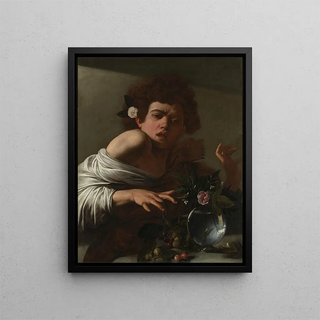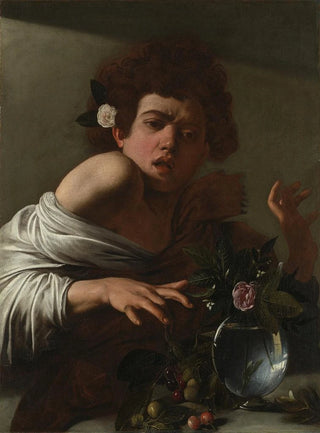Art print | Boy bitten by a lizard - Caravaggio


View from behind

Frame (optional)
The artwork "Garçon mordu par un lézard" by master Caravaggio is an iconic piece that embodies the essence of the Baroque. This painting, both intriguing and striking, evokes a palpable tension between striking realism and psychological depth. The scene highlights a young boy, whose expression combines surprise and pain in response to a lizard bite. This fleeting moment, captured with unparalleled mastery, immerses us in a universe where nature and man meet in an intense visual dialogue. The light, omnipresent in the piece, plays a crucial role, illuminating the boy's face while shadows envelop the rest of the composition, creating an atmosphere that is both dramatic and mysterious.
Style and uniqueness of the work
Caravaggio's style is distinguished by his masterful use of chiaroscuro, a technique that enhances the contrasts between light and darkness. In "Garçon mordu par un lézard," this approach is particularly evident. The face of the young boy, bathed in light, emerges from the surrounding darkness, immediately drawing the viewer's attention. This dramatic staging emphasizes not only the raw emotion of the moment but also human vulnerability in the face of nature's forces. The meticulous details, such as the texture of the skin, reflections in the eyes, and even the depiction of the lizard, demonstrate attentive observation of the living world. Caravaggio does not merely depict reality; he transcends it, offering a visual experience that resonates deeply with the viewer, awakening feelings of compassion and empathy.
The artist and his influence
Michelangelo Merisi da Caravaggio, known simply as Caravaggio, is an essential figure in art history. Born in Milan at the end of the 16th century, he revolutionized painting with his bold and innovative approach. Moving away from the idealized conventions of the Renaissance, Caravaggio introduced a more authentic and human representation of subjects. His influence extends far beyond his time, inspiring generations of artists across Europe.

Matte finish

View from behind

Frame (optional)
The artwork "Garçon mordu par un lézard" by master Caravaggio is an iconic piece that embodies the essence of the Baroque. This painting, both intriguing and striking, evokes a palpable tension between striking realism and psychological depth. The scene highlights a young boy, whose expression combines surprise and pain in response to a lizard bite. This fleeting moment, captured with unparalleled mastery, immerses us in a universe where nature and man meet in an intense visual dialogue. The light, omnipresent in the piece, plays a crucial role, illuminating the boy's face while shadows envelop the rest of the composition, creating an atmosphere that is both dramatic and mysterious.
Style and uniqueness of the work
Caravaggio's style is distinguished by his masterful use of chiaroscuro, a technique that enhances the contrasts between light and darkness. In "Garçon mordu par un lézard," this approach is particularly evident. The face of the young boy, bathed in light, emerges from the surrounding darkness, immediately drawing the viewer's attention. This dramatic staging emphasizes not only the raw emotion of the moment but also human vulnerability in the face of nature's forces. The meticulous details, such as the texture of the skin, reflections in the eyes, and even the depiction of the lizard, demonstrate attentive observation of the living world. Caravaggio does not merely depict reality; he transcends it, offering a visual experience that resonates deeply with the viewer, awakening feelings of compassion and empathy.
The artist and his influence
Michelangelo Merisi da Caravaggio, known simply as Caravaggio, is an essential figure in art history. Born in Milan at the end of the 16th century, he revolutionized painting with his bold and innovative approach. Moving away from the idealized conventions of the Renaissance, Caravaggio introduced a more authentic and human representation of subjects. His influence extends far beyond his time, inspiring generations of artists across Europe.






